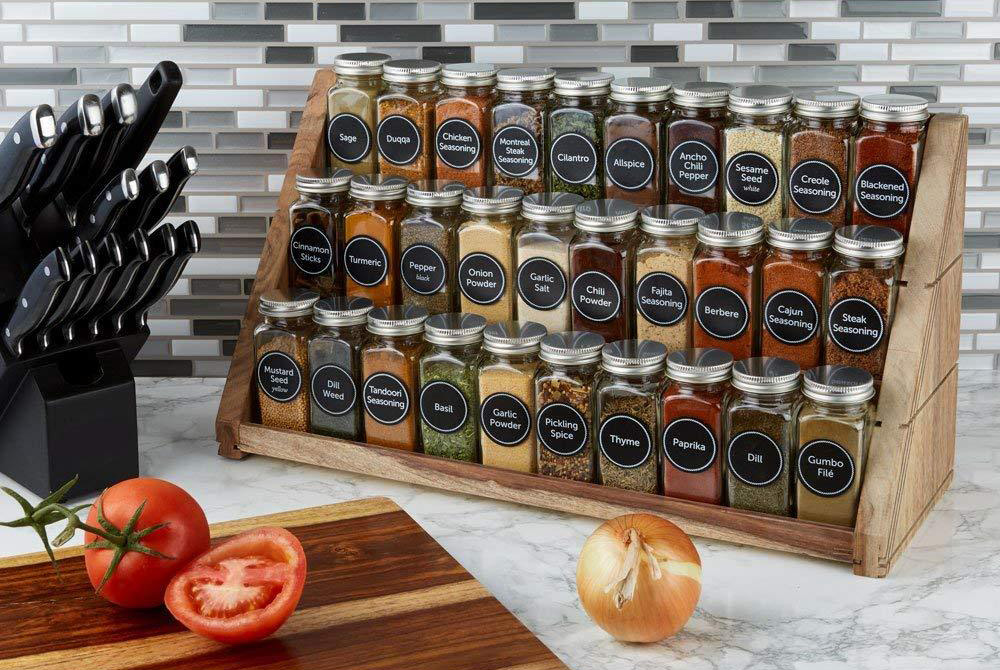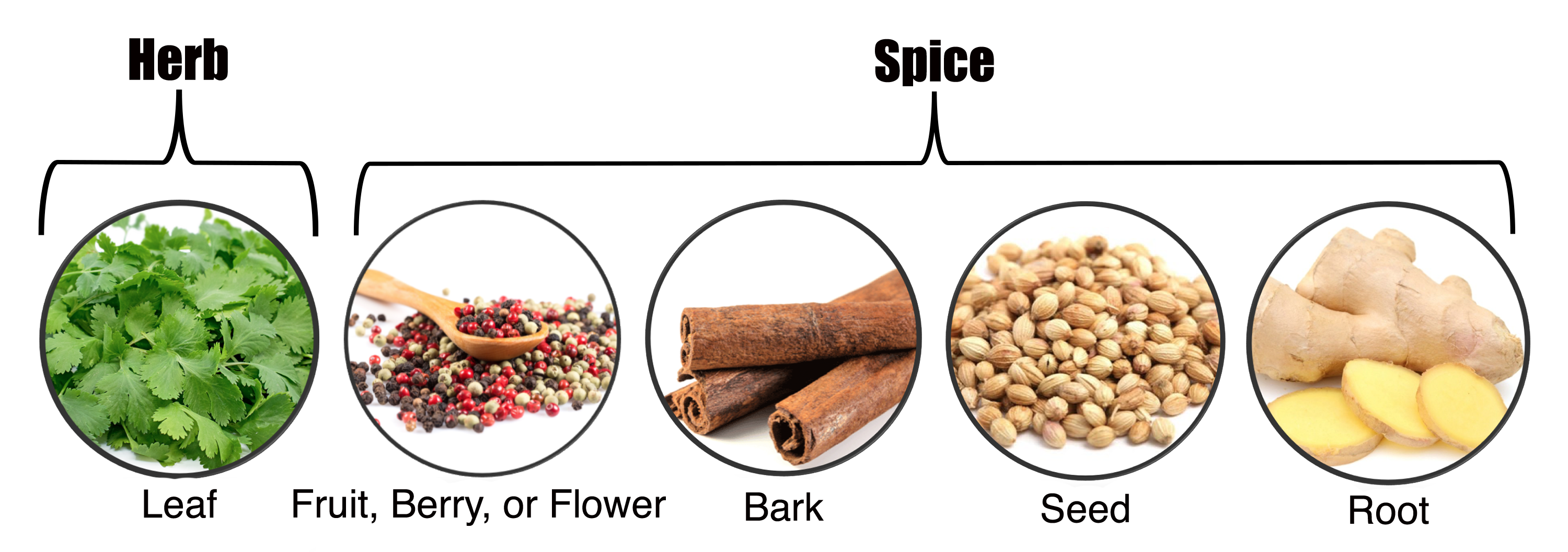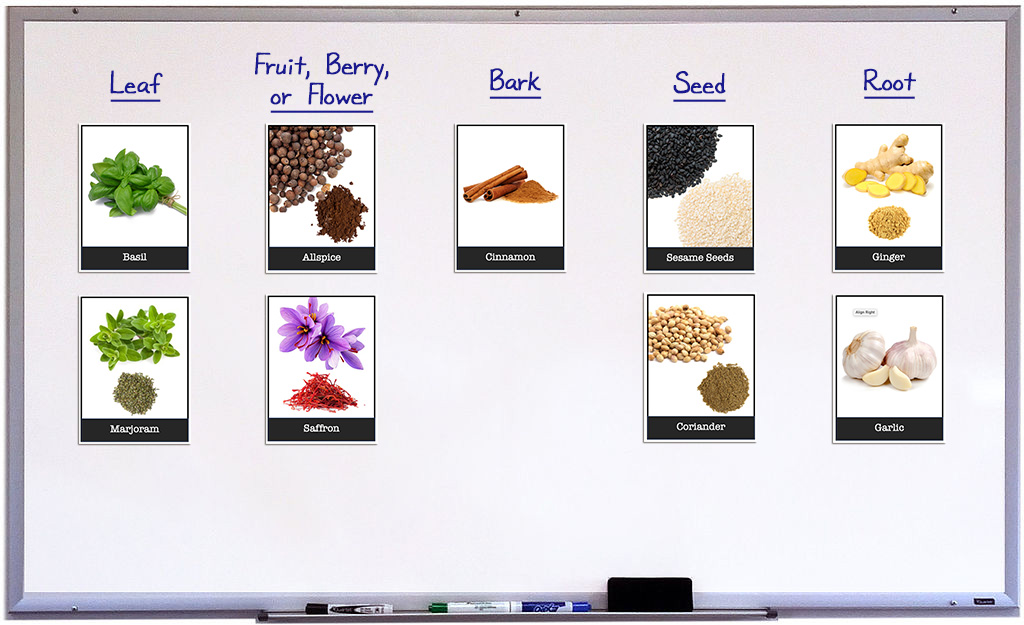 Relevancy and Engagement
minnesota.agclassroom.org
Relevancy and Engagement
minnesota.agclassroom.org
Herbs and Spices of the World
Grade Level
Purpose
In this lesson students will recognize the difference between a spice and herb, learn how herbs and spices are grown on farms around the world, and participate in a culinary challenge to season popcorn for various cultural cuisines. Grades 9-12
Estimated Time
Materials Needed
Engage:
- Herb and spice samples with label covered (see table below for examples)
Activity 1: History and Geography of Spices
- Herb and spice rack image
- Herb and Spice Cards, 1 copy per class, cut into individual cards
Activity 2: Herbs vs. Spices
- Herb vs. Spice image
- Herb and Spice Cards (from Activity 1)
Activity 3: Herbs and Spices From Farm-to-Fork
- The Journey of Vanilla: From Plant to Extract video
- Herb and Spice Cards (from Activities 1 and 2)
- Computer or devices for "Source to Table" assignment
Activity 4: Spice it Up
- Seasoning Mix Cards, 1 copy per class, cut into individual cards
- Plain, air-popped popcorn; 1 large bowl per group
- Seasonings for each group
Vocabulary
Columbian Exchange: a widespread exchange of animals, plants, culture, human populations, communicable disease, and ideas between the New World (Americas) and the Old World (Africa and Europe)
herb: flavorings that come from the vegetative part of the plant, most often the leaves and roots
seasoning: salt, herbs, or spices added to food to enhance the flavor
spice: flavoring that most often comes from seeds, seed pods, and fruit of the plant
Did You Know?
- Peppercorns have been used to spice up foods for more than 4,000 years. As early as the 4th century BC, texts described pepper being used as a seasoning for Indian feasts.1
- Nutmeg trees actually produce two spices—nutmeg and mace.
- It is suspected that the origins of chili powder date to frontier chuck wagons. The first commercial chili powder was sold in the late 1800s. Chili powder is a blend that usually contains chiles, onion, garlic, cumin, and other spices.2
- The United States leads the world in the consumption of spices.3
- The United States leads the world in spice imports. Very few spices are grown in the United States.3
Background Agricultural Connections
Herbs and spices have been used by people for centuries for culinary, medicinal, and even religious purposes. In general, herbs are considered culinary flavorings that come from the vegetative part of the plant, most often leaves and roots. Herbs such as parsley, bay leaves, oregano, summer savory, thyme, sage, basil, and marjoram are leaves. Spices are most often seeds, seed pods, and fruit (usually dried). Black pepper, chili pepper, nutmeg, sesame, mace, mustard, vanilla, cacao, kola, celery seed, turmeric, and almond are seeds, seed pods, or fruit. Of course, there are exceptions—ginger is from a root, cinnamon is from the bark of a tree, and saffron is the actual stamens of crocus flowers.
Herbs and spices come from plants. Plants produce chemicals that provide a wide array of scents and flavors. In nature, these chemicals can repel or discourage pests from eating them. They can also encourage pollinators and other useful animals to eat them and disperse the seeds while repelling other animals. For example, scientists have discovered that mammals can experience the heat of spicy hot peppers while birds cannot. Pepper seeds traveling through the digestive systems of mammals are damaged or even digested by some mammals. When the remnants are spread in the animal’s waste, the seeds are no longer capable of germinating and producing new plants. However, pepper seeds digested by a bird pass through its system unharmed, are spread in the environment, and then germinate and produce new plants. So the bird is the preferred consumer of pepper fruits and mammals are not. The hot spice of the peppers dissuades mammals from consuming peppers, leaving them available for birds to eat.
Herbs and spices used in our foods represent rich cultures throughout the world. Seasonings help identify specific cuisine within various regions of the world. Italian seasonings from the Mediterranean are familiar to foods such as pizza, pasta, and breads. Cajun seasonings are familiar in the Southern United States, while Southwest seasonings are common in the hot, desert states of New Mexico and Arizona.
Many of our foods are produced both near and far, but herbs and spices could represent the richest geographic diversity of all of our foods. These flavor-enhancing foods have been imported and exported across the world since the Columbian Exchange. Refer to additional lessons on the Matrix to cover the Columbian Exchange in more depth.
Engage
- Prior to class, choose three or more of the herbs and spices listed in the table below. Prepare a small sample of each herb(s) and spice(s) and cover up the label.
- Ask for a student volunteer to observe and smell each sample. Ask the student to identify the food or foods that come to mind when they smell the seasoning. Seek responses from multiple students, noting that more than one food may be associated with each seasoning and it may vary from person to person.
Food Herbs and Spices Turkey dressing Sage, Onion Pizza Oregano, Garlic, Bay leaves Apple pie, Rice pudding, or Wasail Cinnamon, Nutmeg Ginger bread, Gingersnaps, Ginger ale Ginger Spaghetti Bay leaves, Onion, Garlic Garlic bread Garlic Dill pickles Dill, Garlic Pumpkin pie Cinnamon, Nutmeg, Allspice - After students have successfully paired the herbs and spices with foods, ask, "How important are herbs and spices to achieve the correct (recognizable) and ideal taste for each food? Are herbs and spices important to the taste of our food?" Allow students to offer their responses. Further illustrate by asking what spaghetti sauce would be without seasonings (tomato sauce) or what turkey dressing and pumpkin pie would taste like at Thanksgiving without herbs and spices (dry bread and cooked squash).
- Direct student responses and further questions to help students recognize that herbs and spices are critical to create foods with familiar tastes. Students should also recognize that different individuals and families associate different foods with the same herbs and spices. Culture plays a role in food tastes, smells, and associations.
Explore and Explain
Activity 1: History and Geography of Spices
- Show students an image of a culinary spice rack. Ask the following questions:
- How did herbs and spices play a role in history?
- The value and demand for spices was a driving force in the Columbian Exchange. Herbs and spices in addition to plants and animals were exchanged between the New and Old World in the Columbian exchange.
- How do herbs and spices play a role in cultures throughout the world?
- The earliest written records indicating the use of herbs and spices come from ancient Egyptian, Chinese, and Indian cultures. They were used for medicinal purposes and to flavor and preserve foods. Today, herbs and spices help flavor foods with origins all over the world.
- What kind of geography do herbs and spices represent?
- Herbs and spices are produced all over the world. Even today they are a common commodity for agricultural imports and exports.

- Herbs and spices are produced all over the world. Even today they are a common commodity for agricultural imports and exports.
- How did herbs and spices play a role in history?
- Give each student one Herb and Spice Card. There are a total of 30 cards. For larger classes, pair students as needed. For smaller classes, give students more than one card or omit cards as needed.
- Project a world map on the board. Explain that every ingredient that makes up the food on our plates comes from somewhere in the world. In the case of herbs and spices, the countries of origin can be very diverse.
- Give students three to five minutes to discover where in the world their spice or herb is commonly grown. Instruct them to use a computer or device to search a phrase such as, "Where are [cloves] grown?" or "Where does [cinnamon] grow?"
- Note: Although salt is not a spice or an herb (it is a mineral), it is used in our cuisine similar to herbs and spices to enhance flavor. Inform the student with the salt card to search for where salt is mined.
- Once students have discovered a common or likely origin of their herb or spice, they should place their card on the map on or near its country of origin.
- Note: Students will likely find more than one country that produces their particular herb or spice. Have students select one country to best represent the origin of their herb/spice.
- Once all of the cards have been placed on the map, lead a class discussion with questions such as:
- What patterns can you see regarding the common origins of herbs and spices?
- Does climate seem to impact the ability to grow common herbs and spices?
- Are more herbs and spices grown within the United States or abroad?
- Conclude with students that while some of our food supply is produced outside of the United States, herbs and spices likely represent the most geographically and culturally diverse products in our kitchens.
- Have students collect their Herb and Spice Card from the board to prepare for the next activity. They can collect their original card, or another one if they'd like to switch it up.
Activity 2: Herbs vs. Spices
- Ask students if they know the difference between an herb and a spice. Explain that all herbs and spices originate from plants. The portion of the plant they are derived from determines if they are an herb or a spice.
- Project the Herb vs. Spice image on the board.

- Give students three to five minutes to research their herb or spice and discover which portion of the plant it comes from.
- Have students place their cards on the board categorized by the portion of the plant it comes from. This can be done by dividing the board into titled columns.

Activity 3: Herbs and Spices From Farm-to-Fork
- Explain that every food we eat has a journey from its source (usually a farm), to our table. Herbs and spices are no different.
- Show the 4 minute video clip, The Journey of Vanilla: From Plant to Extract.
- After watching the video, review and answer questions such as:
- Where is the vanilla bean grown? (Mexico is mentioned in video. Other countries include Madagascar, Comoros, and Reunion)
- How did the introduction of the vanilla flavor by Hernando Cortez affect the demand for the vanilla flavor in other parts of the world? (As the vanilla spice was introduced in Europe, demand grew. Although it could not be grown in Europe, the vanilla bean could be imported from its country of origin.)
- How did advances in science improve the cultivation of the vanilla bean? (Charles Morren discovered how to hand pollinate the flowers rather than relying on bees for pollination.)
- Assign students to research their herb or spice and outline the journey from "Source to Table." Depending on time and resources available, choose from the following options:
- Make a 1-page infographic.
- Create a Prezi.
- Create an Augmented Reality presentation using HP Reveal.
- Create a "How-to" brochure for growing, harvesting, and preparing the herb/spice for culinary use.
Note: Some of these herbs could be grown in your classroom or purchased from the garden section of a local store or nursery allowing students to see the plants in person.
Activity 4: Spice It Up
- Now that students have a foundational knowledge of herbs, spices, and their various sources, ask them what the term seasoning means. Explain that seasonings refer to all of the salt, herbs, or spices added to a culinary dish. In most cases, it will be a mixture of herbs, spices, and salt rather than a single herb or spice.
- Divide the class into a maximum of eight groups, less if needed. Assign each group a specific seasoning using the attached Seasoning Mix cards.
- Explain to the class that they are being challenged to make a homemade seasoning mix and recipe to flavor popcorn in the style/flavor they have been assigned.
- Provide a bowl of plain, air-popped popcorn to each group as well as access to the herbs and spices they will need. Encourage students to research seasoning mix recipes before they select the one they will use.
- Teacher note: Students can find an official popcorn recipe for each of the assigned seasoning mixes by searching online. Determine ahead of time if you'd like students to create their own recipe or follow an existing recipe.
- Provide an appropriate amount of time for students to prepare their popcorn. Label each bowl and provide remaining students with small cups to test each flavor of popcorn. Have students vote for their favorite flavor(s).
Optional Adaptations: Rather than using popcorn, students could also use plain rice to create a savory side dish. Another more advanced culinary challenge would be to create a pizza for each culinary/flavor style. In addition to the seasonings, students can experiment with sauces and toppings for their pizza as well.
Elaborate
-
Watch The Geography of Spices and Herbs (12:25).
-
Ask students to identify a seasoning most likely found on almost all tables in the United States. Salt and Pepper! Listen to or watch the NPR Podcast, How Did Salt and Pepper Become The Soulmates Of Western Cuisine?
-
Assign students to select a recipe containing herbs and spices that is unique to their own (or someone else's) cultural heritage. Have them research the origin of the recipe along with details such as where the herbs and spices are grown, how they are processed, and how/when the recipe is consumed (traditional holiday meal, cultural event, or everyday dish).
-
Start an herb garden in your classroom for students to observe the plant growth of basic culinary herbs. Basil, chives, dill, oregano, parsley, rosemary, sage, and tarragon are easily grown and several will be familiar scents to students. Plant seeds in peat pots and place in a warm, sunny window. Once the plants are growing well, keep them trimmed by harvesting the leaves and prevent the herbs from flowering and setting seed. (Annual plants will often die after setting seed.) When the herbs are growing well, snip off portions of leaves and stems. Crush the herb cuttings to release the essential oils and place them into small paper bags. Conduct a blind smelling test by having students smell the herbs and try to identify the herb and/or what foods the herb might be used in.
-
Watch Turmeric - How Does it Grow? Discover what fresh turmeric looks like before it's mature and ground into spice.
Evaluate
After conducting these activities, review and summarize the following key concepts:
- Herbs and spices are grown on farms throughout the world.
- Many herbs and spices require very specific types of climates for growth. Some spices can only be produced in very select geographic areas.
- The demand for herbs and spices was historically a driving force of the global economy. Although transportation and shipping is easier today, herbs and spices are still part of global trade and economics.
- Like other products, herbs and spices are produced in response to consumer demand and often represent specific cultures.
Sources
Acknowledgements
The original Spice it Up lesson was written by Florida Agriculture in the Classroom. The lesson was updated and re-written with permission in 2019 by the National Center for Agricultural Literacy.